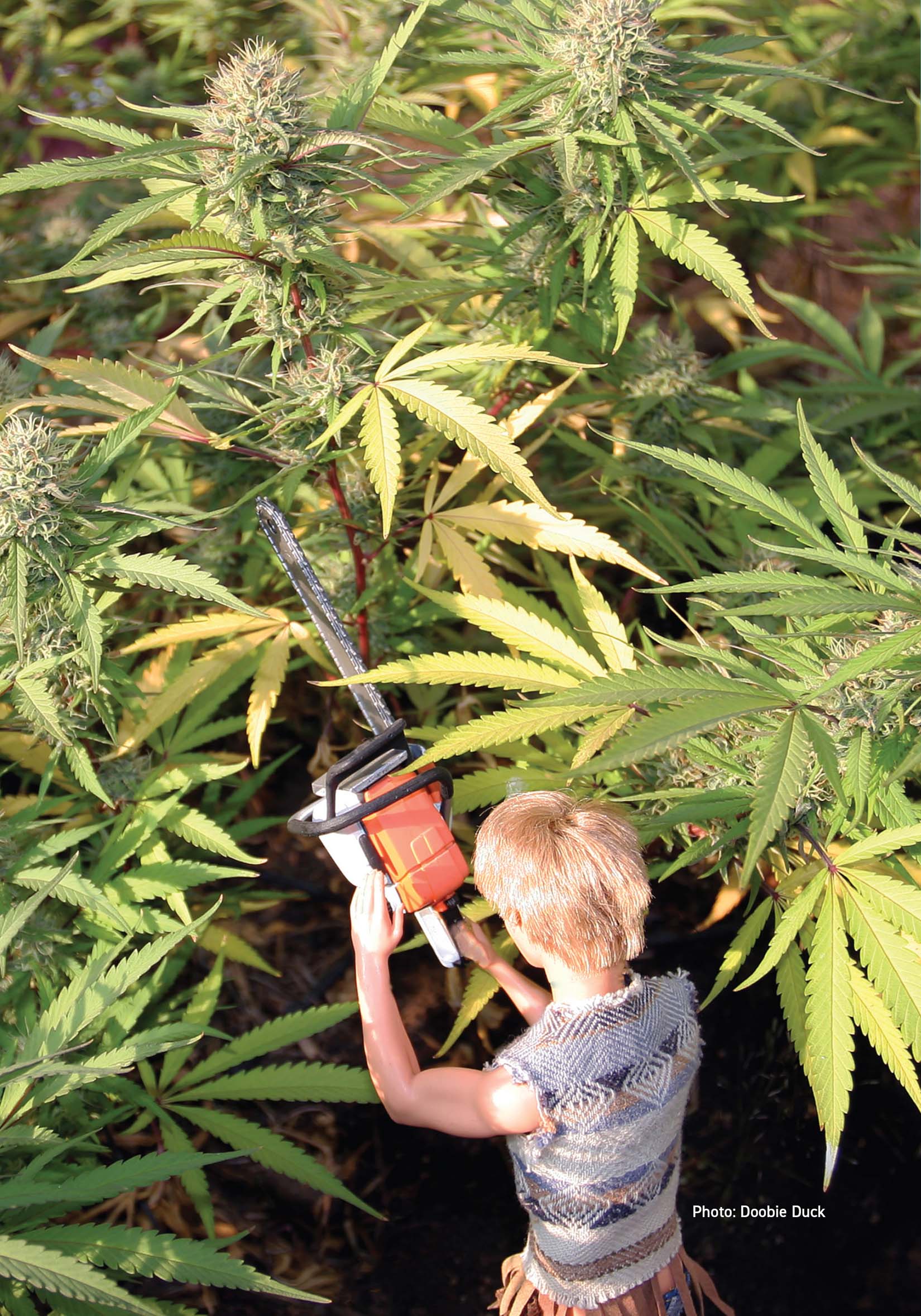
PICKING
Harvesting Strategies Outdoors
The harvester has a few choices: cut the whole plant or sections of it; cut individual branches; cut just the ripe buds and leave the rest to ripen; or cut all the buds, separating them into As for “trophy flowers” and Bs for smalls.
Why would a grower consider cutting the whole plant? Perhaps weather conditions are severe enough to require a rapid harvest, or, if the grower is working with a crop that ripens evenly and is ready to harvest at the same time, the grower may choose to cut whole plants in order to harvest the entire crop at once. The choice may be determined by labor availability. A grower can choose a large crew to cut and dry the product all at once, a surge crew to work for a limited period of time, or, depending on financial constraints, a crew to trim when demand for labor is lower.
Another choice is to cut individual branches as they mature. Cutting off the outer branches opens the inner buds to light, hastening their maturity. A grower may harvest individual buds for the same reason: doing so provides the immature buds underneath with more light.
When plants are spaced tightly in rows and bottom-pruned, all the buds grow on the top portion of the plants. They can be cut using a hedge trimmer, leaving the understory to ripen or to be harvested separately for concentrates/extracts.
Other factors may lend themselves to harvesting only the ripest buds. If the weather is predicted to stay fair for a long period, a grower may choose to change the flow of the harvest by slowing the process down and trimming off the best buds as they become perfectly mature.
Buds and branches can be sorted into As and Bs, using the material for different purposes. Shake and imperfect buds are used for concentrates, while high-quality buds are trimmed.
With smaller plants, most of the buds are often ready at the same time. Either the whole plant or the colas can be cut. All material that is removed from the plant should be placed on hygienic tarps, bags, or other containers.
Picking Outdoors
Outdoors, where maximum size or height might not have a limit, huge plants can be harvested over two or three stages by taking the ripened portion of each branch and leaving the unripened portions to finish over the next week or two.
Outdoor growers have little control over temperature, humidity, and wind. Ideal conditions for picking are cool and dry, less than 70°F (21°C), and low humidity. In reality, poor weather may require an early harvest. The best time to harvest is before dawn or early morning, when the plants contain the most terpenes.
Plants grown using a sea-of-green method have a single layer of tops because very little light pierces the canopy. Industrially they can be harvested with a scythe. Monster plants spaced farther apart absorb light over their entire height.
There are two possible paths, depending on growing conditions and the grower’s needs: a slow, elongated period of harvesting, or one big harvest. Most indoor farms use the former, while outdoor operations often use the latter.
Growers who harvest all at once should plan for staff. There is a surge of work that can be accomplished in a burst or over a longer period.
Another strategy eliminates the need for a temporary labor surge. First, all labor is devoted to harvesting. Plants are cut and hung to dry or are placed in a refrigerated space where they remain fresh for processing. Then, they are processed over time.
When only a clone or stabilized seed variety is grown, all the plants ripen within a short window. If labor is limited, using a staged harvest paces the work. These buds are processed as the next group ripens. During the growth cycle, fertigation is easier because the same formula is used for all the plants at the same time. Another way to limit labor surges is to use several varieties that mature at different times so that the harvest takes place over a longer period.
Growers face harvest pressures caused by improperly planning for environmental factors. Sunny, warm, dry weather is ideal for ripening. The sun powers photosynthesis and provides energy for ripening. The warm weather promotes fast growth, and with little moisture there is less chance that powdery mildew or other infections will occur.
Gardens often have those conditions all summer long, but in autumn the plants are in a tug-of-war with nature, ripening just as conditions get more challenging. Light intensity and UV light levels are diminishing, and it may be cloudy, foggy, or rainy—all perilous environmental conditions. Growers must contend with autumn’s rapidly changing climate.
Wet Harvest
Harvesting in fog or rain presents special problems because wet vegetation is vulnerable to attack by bacteria and mold. In this situation, prepare the plants or branches by hanging them or placing them on drying racks, leaving more space than usual to promote drying. Quickly remove excess moisture from the leaves by raising the temperature to the mid-70s F (23-24°C) and circulating the air while removing moisture with a dehumidifier. This lowers the risk of infection and decreases drying time. Once the water on the leaf surfaces has dried, resume normal drying techniques.
Preparing for Bad Weather
As the crop ripens, monitor the weather forecasts for at least two weeks before planned picking. Take the forecasts into consideration when selecting harvest dates. Depending on the conditions, growers may choose to harvest, protect the plants with covers or tarps, use drying equipment, and/or spray with protectants. Usually large-scale outdoor growers proceed cautiously. They choose not to risk the whole crop to botrytis just to gain a slightly higher cannabinoid potency. Moisture is a problem, as dense, thick buds are more prone to mold than fluffy or thin bud varieties.
If the light-deprivation greenhouse harvest must be picked early and there is sufficient warning, speed up ripening by increasing the dark period to 14 hours daily. This induces the plants to ripen faster at the cost of bud size. Turning off the light a day or two before harvesting also helps a little with ripening and may increase cannabinoid and terpene content. Keep temperatures in the low 70s (around 21°C) and the humidity below 50% in the dark space to prevent mold infections.
Once the grower determines that the buds are ripe, it’s time to pick.
Picking: Step-by-Step
- Plan: Estimate the date the buds will first be ready to pick. Schedule time and resources for picking.
- Inspect for ripeness: Regularly examine buds for signs of ripening.
- Deleaf: If convenient, about three weeks before harvest, remove fan leaves that aren’t getting light or are blocking buds from direct exposure to light. Remove other fan leaves a week to a few days before harvest.
- Prepare: Ready the tools, equipment, and drying area. Clean and inspect all equipment to make sure it is working. Tune up tools by sharpening, oiling, and charging them. Make sure there are enough tarps and baskets and an area large enough to store the harvest.
- Disinfect the processing and drying/curing areas: Clean all surfaces and tools with hydrogen peroxide, bleach, or other disinfectants.
- Cut: Remove buds when they have reached peak potency. Or cut entire branches of buds the same length for easier processing.
- Sort: Place picked buds or cut branches in trays for transfer to the trimming or drying area. To capture the greatest amount of THC and terpenes, plants should be harvested toward the end of the dark period. If the garden is outdoors, the best time is before sunrise. If the garden is indoors, it is best to leave the lights off during the harvesting process and pick after the plants have gone through a full dark period. Cannabinoids and terpenes accumulate during that time, so an extended period of darkness produces the most cannabinoid content.
Growers have many choices of how to harvest. Here are some different styles.
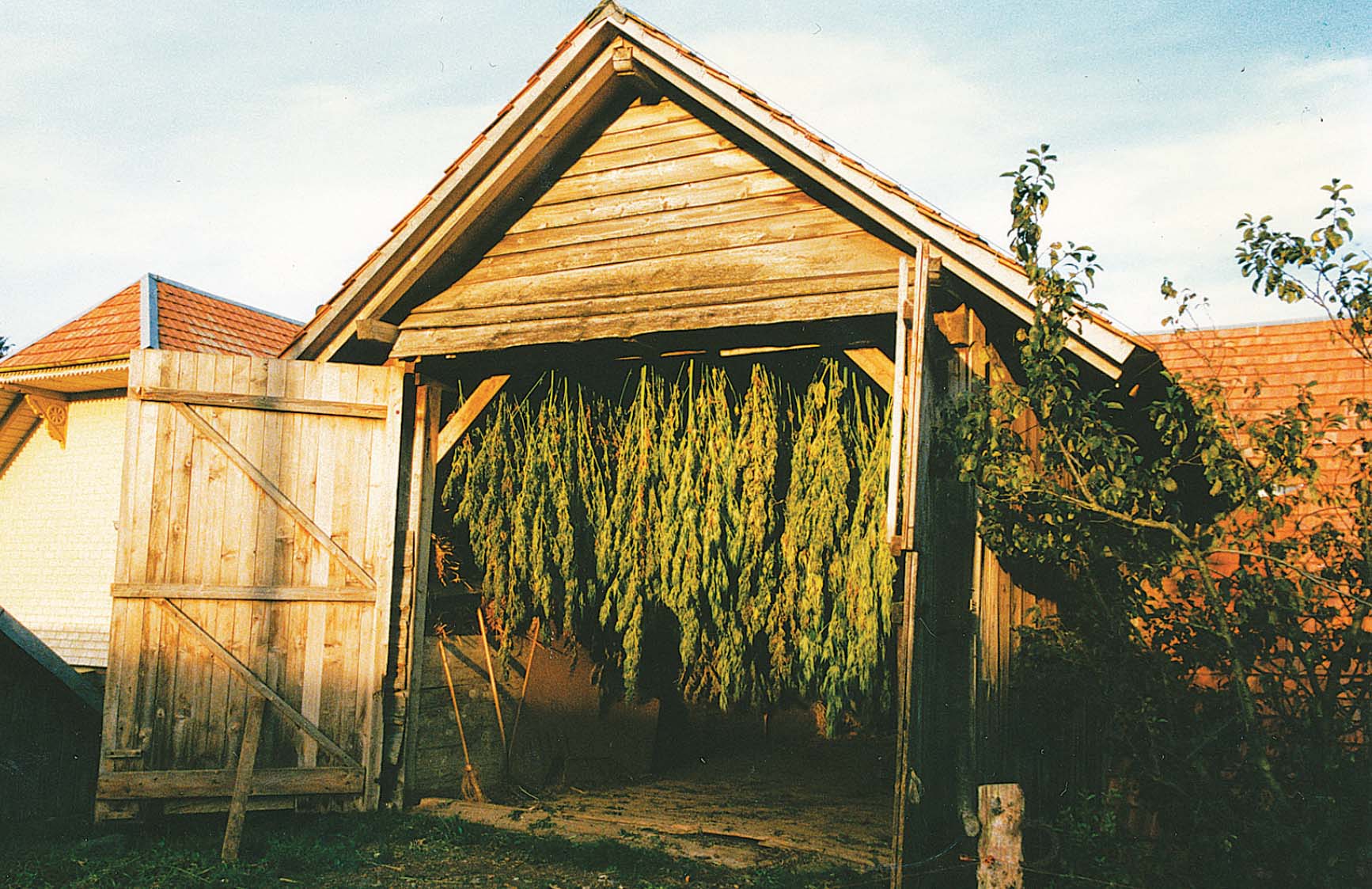
This 1980s Swiss cannabis farm uses an old-fashioned method of harvest: chopping the whole plant at the base of the stock and hanging it upside down in a large barn, shed, or warehouse. Photo: Ed Rosenthal
Whole Plant
There are several reasons for cutting the whole plant at once:
- The plants are tagged and, due to track and trace compliance, must remain intact until further processing when the tags are removed.
- The buds have matured at the same time. (This often happens on small plants or when the entire plant is fully illuminated. All the buds on sea-of-green plants usually mature at the same time.)
- Weather conditions are threatening.
- The entire plant, or most of it, is to be used for extracts or concentrates, so full cosmetic ripening is not important.
- Space needs to be made for new planting. (If the planting area is scheduled to be replanted, waiting for some buds to ripen throws off the schedule. It is usually not worth the time delay.)
Pros: The plants are quickly removed from the field or room and away from environmental stresses.
Cons: Not all the buds are perfectly ripe. Some are either overripe or immature and may be best used for concentrates and extracts.
Individual Ripe Branches & Buds
There are several reasons to cut buds and branches (or sections of branches) as they ripen:
- Some branches may be in the shadow of other plants or other obstructions, especially in autumn, when the sun’s angle is more oblique. Removing ripe branches often allows light to reach the other less-developed flowering sites.
- Cutting branches may be more labor-efficient than cutting the whole plant.
- A large plant may be too heavy and bulky to cut at the stem, so it has to be taken down in pieces.

The branches are easily bunched for transporting. Photo: David Downs
Pros: Harvesting individual buds and branches as they ripen gives lower buds hidden inside the canopy the chance to fully mature for another one to two weeks. There is a significant difference in potency and quality between unripe and ripe buds, so the extra time and labor required for multiple harvesting sessions or daily bud inspections are worthwhile. Another advantage is that the most valuable buds are removed first and therefore safeguarded. The inner buds are not nearly as valuable, especially when harvested too early.
Cons: Harvesting individual buds and branches takes more time and labor than cutting whole plants. Some experience is needed to recognize ripeness.
Ripe Portions of Colas
Most colas ripen first at their tips, and the ripeness travels inward. One portion of the cola may be ripe, while the other portion is not. For perfection, the ripe portion can be harvested, and the inner portion will ripen as it receives more light.
Water Deprivation
Experienced growers practice slight water deprivation one to two days before harvest. This creates a stress response so that more cannabinoids and terpenes are produced. The deprivation should not be so severe that it leads to wilting.
Picking Indoors
Adjust the garden temperature down to the low 70s F (21-22°C) and lower than 50% humidity before harvest. The cooler temperature keeps the terpenes from evaporating, and the low humidity minimizes the threat of mold.
Late Picking
Some growers allow extended ripening times for increased density and/or a shift in color. If harvesting is delayed, the risk of trichome caps popping off their stalks increases.
Equipment Used for Picking
- Schedules: keep track of the entire process and manage various important factors and tasks.
- Photographer’s loupe or a magnifier: monitors trichome development and ripeness.
- Cutting Tools: described below.
- Tarps: place around large plants when cutting them.
- Shelves or hang lines: hold whole plants, branches, colas, or buds.
- Transporting equipment: moves material from field to processing. This may be a basket or a hand-drawn garden cart, small motorized transport, or a portable conveyor belt.
- Cold storage: keeps the buds cool and turgid while awaiting processing or fresh-frozen capabilities.
- Cleaning supplies: vacuum cleaners, brooms, dustpans, alcohol and hydrogen peroxide, clean rags, paper towels, soap and water, resin removers such as potassium hydroxide (KOH), or commercial resin solvents.
- Changing/Sanitation Rooms: workers should practice proper hygiene, and washing facilities should be available.
- Gloves: for all phases of the operation, from plant cutting to manicuring. Canvas, rubber, and/or latex gloves are necessary.
- Pruning shears, scissors, or power cutters: sharp and sanitized.
- Food-grade plastic trays: hold material for sorting fan leaves, branches, colas, trim, buds, and waste material.
- Ergonomically correct tables and chairs
- Solvent: such as isopropyl alcohol, olive oil, or commercial resin degreaser to clean resin off scissors and other surfaces.
Manual Cutting Tools
Choose tools based on ease of use, efficiency, and comfort. Below is a range of trimmers—small and large, long- and short-handled—as well as a sense of what to look for in a high-quality trimming tool.
The garden section of hardware stores likely has three kinds of hand tools useful for picking cannabis: bypass, anvil, and ratchet tools.
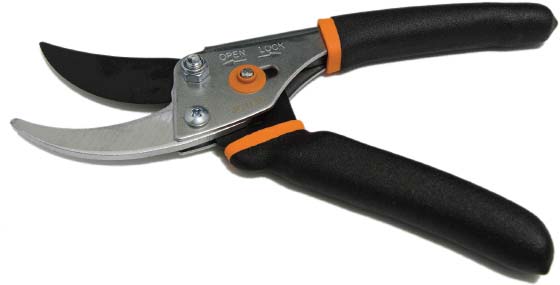
Bypass: A bypass cutting tool works by sliding a straight blade past another blade. The bypass cutter’s scissor-like motion works well for cutting live green plants. The firm outer wall of the plant yields easily to this bypass motion. Bypass cutters have a stainless steel curved blade on the bottom of the tool and a straight blade on top. The straight blade passes next to, not on top of, the lower surface, sometimes called the hook. The lower blade’s curvature is designed to hold the branch or stem while the cutting blade descends and cuts. Bypass cutters offer a very clean cut because the blade slices all the way through the plant material. Use bypass pruners for branches up to three quarters of an inch (2 cm) thick, bypass loppers for branches up to one inch (2.5 cm) thick, and a handsaw for anything larger.
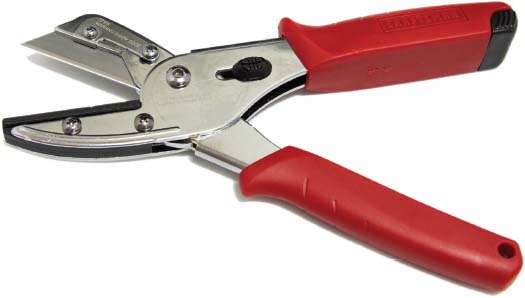
Anvil: Anvil cutters work by bringing a straight blade down against a wide anvil, often made of rubber or steel. This crushing motion is most effective when working with thick and stiff or dead and dried-out plants. When used on live plants, anvil cutters tend to crush the soft tissue of the plant, stopping the flow of nutrients and prolonging the healing time for the cut surface. An anvil cutter dulls less quickly than a bypass cutter and can’t be damaged when twisting the tool in the cut, as can happen with bypass cutters.
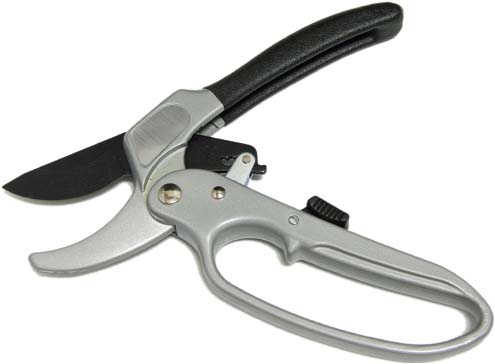
Ratchet: Ratchet pruners are used to cut thick branches or stalks. They are either hydraulic or pneumatically driven. One handle is stationary and the other moves. The lower jaw of the pruner hooks around a stalk or branch when the handle is pumped. As the blade sinks into the material, the ratchet gear clicks into place. The user then continues the pumping motion until the cut is complete.
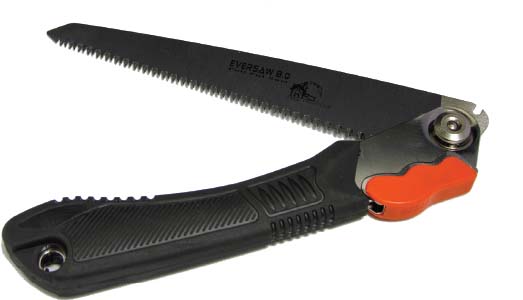
Small pruning saw: When a branch or stem is too large or unwieldy to make a clean cut with a cutter or a lopper tool, a small pruning saw is a good alternative. There are two types of pruning saws: straight and curved blade. As the name indicates, straight-blade pruning saws have straight blades. Though the blades are straight, the handles are often curved, like a pistol grip, making it more comfortable to use. Straight-blade pruning saws are best used for green plant material.
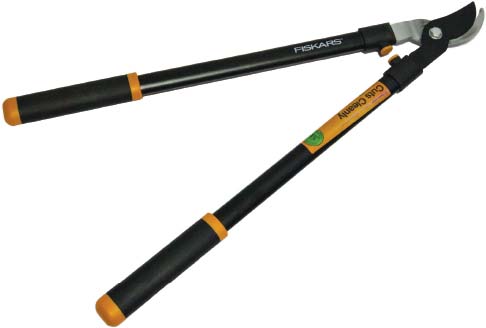
Loppers: The long handles of a lopper allow the reach to be extended with minimal effort, enabling the user to cut anything that can fit between the two blades. Curved blades are best for heavy-duty cutting. The curvature of the blade allows the user to add additional force to the cut, slicing through even the toughest branches and stalks. Using a pruning saw or lopper takes time, so growers working with large plants should consider electric tools to increase efficiency.
Power Trimmers & Clippers
Use of portable electric tools speeds up the process of cutting branches and ripe colas, by a factor of three to eight times the pace of manual work. Electric hand garden trimmers often come with two different blades that facilitate precision work.
They can be used when leafing and are useful when harvesting small plants or buds, or even just the ripe portion of the buds, leaving the unripe portions. Each of the two blades is small, usually a hedge trimmer about 10 inches (25 cm) long and a grass shearer about 3 to 4 inches (7-10 cm) wide. Depending on the bud formation and plant shape, both of these cutters can be used to remove the ripe buds from the plant, leaving the unripe buds or just the branches and the leaves from which the buds stuck out.
Versions of these tools come with pole extensions up to 10 feet (3 m), so tall plants can be trimmed while the worker stands on the ground rather than on a ladder or platform. This is an important issue because workers are more likely to sustain an injury when working while elevated.
Large Hedge Trimmers
Removing branches is easy with a hedge trimmer. Hedge trimmers can also be used to harvest buds or remove just the ripe parts of buds. Hedge trimmers have blades that are 12-24 inches (30-60 cm) long. Smaller trimmers are adequate for most plants and weigh less than models with longer blades, so workers don’t tire as quickly. A hedge trimmer with an 18-inch (45 cm) cutting area allows workers to reach tall branches and into bushy plants. Trimmers can be directed very accurately to remove individual buds as well as branches.
If the branches are too thick for the trimmer to handle efficiently, a reciprocating saw or small chain saw can be used. Lightweight models are easy to wield, even for higher branches.
Harvesting time decreases 50% or more when power hand trimmers, hedge trimmers, and power saws are used. Plants growing in a Christmas tree formation can be harvested with five strokes. There are four columns of branches, one on each side. First, a clean tarp is laid down to catch the cut branches. Starting with the top branches on one side of the plant, the branch is cut near the node, where it meets the stem, and the trimmer goes down the length of the plant. All the branches will fall into a neat pile on the tarp. Move to each side consecutively. Then cut the top.
The buds on the branches will be the same size and equal length; only the bare portions of the branches will differ in length. The branches will collect in neat piles because the buds aren’t touched while cutting. Bushy plants and plants with multiple branches are also easy to cut using a hedge trimmer. A giant plant that takes up to 15 minutes to cut with hand tools falls to the trimmer in a few minutes. Using power tools results in less contact and thus less damage.
Afterward, either the tarps containing the buds can be rolled up or the buds can be placed in containers. Then they should be quickly moved to a cool area for processing.
Depending on the distance from the field or indoor garden to the next station, a simple garden utility cart, an electric utility vehicle, or motorized transport such as a golf cart may be practical. At this point there are two avenues a grower may choose: trim while the plants are wet or when they are dry. Each has its advantages and disadvantages. (See Trimming.)
The inner branches contain no buds and very few leaves. Rather than sorting later, the operator selects only the budded colas for harvest. A tarp is laid around the plant to catch the falling buds. When the cutting is done, the tarp is pulled away from the plant, folded into a bundle, and transported to the processing area.
Since the buds are not touched during the cutting process and are soft and pliant because they are fresh rather than dried, they suffer little damage from exposure to the vibration of power tools.
This photo series started with the low branches already removed. The rest of the plant was cut to the ground in less than 60 seconds. Compared with cutting by hand, there is less damage to the buds. A tarp placed underneath the plant makes it easy to gather the harvest and move it to the processing area—a 5-to-10-minute process completed in less than 2 minutes.
Mini Hedge Trimmers
The efficient way to cut buds from plants with mini hedge trimmers:
- Place a tarp under the plant to catch all the buds or branches that are about to fall. Start with the vegetation closest to the ground and cut the buds along the stem upward. They will fall off the plant in much the same way that hair drops when it is cut. Work up the plant in an orderly manner. If the buds are too tall to reach, use a secure step stool to increase reach. With the right equipment, workers should be able to easily cut the buds from a plant 8-10 feet (2.5-3 m) high.
- Small hedge trimmers are most useful for cutting small branches and individual buds. They work very well on bushy plants. The buds from a garden of sea-of-green plants are easy to harvest using these tools. When the trim has been completed, the plant will still look green but will be bereft of buds or will hold only immature buds left to ripen.
Battery-Operated Shears
Electric clippers do the work, eliminating strained muscles and carpal tunnel syndrome. A hand-held, battery-operated trimmer is useful for removing large leaves and exposing the buds, making more precise trimming easier.
Transportation
Depending on the size of the crop and the distance the buds or branches need to travel to be cleaned, processed, and cured, a variety of transportation methods can be used. The simplest method involves transporting trimmed buds in boxes or hand-drawn carts. Several carts may be connected to make a small train drawn either by humans or by machines. For bigger grows, where the distance from the processing station increases with the quantity of material, efficiency of transport becomes a greater factor, so utility vehicles, trucks, or conveyor belts are used. Cover the produce while it is being transported to avoid dust contamination when transporting harvested cannabis from the field.
Cleaning Outdoor Crops
Sanitation is something to monitor because of stringent quality controls in the commercial market and user sensitivities for home-grown material. Prevent contamination by using tarps to keep plants from touching the ground. Keep dust to a minimum by spraying down dusty gardens before beginning harvesting.
After picking, some outdoor growers clean their crops with hydrogen peroxide. When the plants are growing in a windy environment, the sticky resins trap and hold dust, dirt, mold spores, and bacteria from the air. Both indoors and out, powdery mildew infections can cover a plant. The solution should be about 0.66%. Drugstore H2O2 is a 3% solution. A simple equation can be used to calculate how much water is needed to dilute store-bought H2O2 to a desired concentration:
M1 • V1 = M2 • V2
M = Molarity (or concentration)
V = Volume
The volume of store-bought H2O2 at a concentration of 3% needed to get 1-liter (1,000 mL) of 0.66% H2O2 is 222 ml; 222 ml of 3% H2O2 and 778 ml of water add up to 1,000 ml of 0.66% H2O2.
If the hydrogen peroxide used is greater or less than a 3% solution, adjust the water ratio up or down accordingly. Hydrogen peroxide is the preferred sanitary agent if washing outdoor-grown crops is necessary because it leaves no residue.
Dip the freshly cut branches in the solution. Some growers soak branches for up to 30 minutes. Others just do a quick dip. There has been little research on this method of cleaning. The water will turn a muddy color but will not strip the branches of trichomes or chlorophyll, only the dirt. Immediately set the washed material out to dry. Hanging is best. Use wind and fans to quicken the process.
If hydrogen peroxide is unavailable, a similar cleaning technique can be employed by mixing a ¼ cup (60 ml) of lemon juice and a ½ cup (118 ml) of baking soda in 3.5 gallons (13 l) of water.
Some ways to keep dust to a minimum:
- Outdoors, moisten paths and unpaved roads to settle mud and dust. Cover bare soil with old rugs placed upside down.
- Use enclosed trailers for transporting harvested cannabis in dusty areas.
- Inside drying spaces use air cleaners with UVC lights enclosed that capture particles in filters. The UVC lights kill airborne spores and bacteria.
- Filter incoming air. Particulate filters remove the larger particles. Carbon filters clean the circulating air. They keep the smell down inside the room.
- Keep the surfaces “restaurant clean” by regularly wiping down tables, chairs, prep areas, floors and entrance ways with hydrogen peroxide, isopropyl alcohol, or other disinfectants.
- Keep a filtered wet/dry vacuum handy for use in cleaning debris and messes.
- Cover harvested material to prevent it from picking up dust, fungal spores, or bacteria during transport to drying or processing areas.
Hygiene Rules
- Use best sanitation practices: wash hands, use hygienic gloves, sweep debris, and clean work areas after each project. Everything—tools, cleaning equipment, storage boxes—should have its own space and be labeled with procedure for use, if necessary. Do the same thing for outgoing material. Everything should be sorted and marked.
- Process the harvest in a different area than the growing space to avoid contamination by workers and their clothing or tools.
- No pets should be allowed into the growing or processing areas.